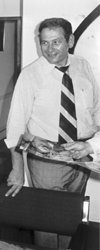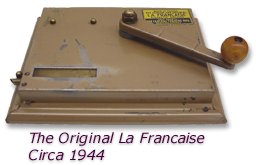 |

|
|
 There are people who innovate and there are those
that improve and develop, for a practical world, the innovations of others. Just as
writers often make poor editors of their own work, so it is that few people can both
innovate and improve their own innovations and do it as well as well as others who are not
so personally involved with their particular brainchild. It is apparent that Arnold
Kastner is such an innovator. Kastner, born in 1925 in Mannheim, Germany, is the
man behind the Supermatic as we know it today in the US and Canada. His father, Morris
Kastner, a furniture manufacturer with a factory and showroom near Mannheim, moved his
family business from Germany to Montreal in the mid 1920's. In 1934, Morris brought the There are people who innovate and there are those
that improve and develop, for a practical world, the innovations of others. Just as
writers often make poor editors of their own work, so it is that few people can both
innovate and improve their own innovations and do it as well as well as others who are not
so personally involved with their particular brainchild. It is apparent that Arnold
Kastner is such an innovator. Kastner, born in 1925 in Mannheim, Germany, is the
man behind the Supermatic as we know it today in the US and Canada. His father, Morris
Kastner, a furniture manufacturer with a factory and showroom near Mannheim, moved his
family business from Germany to Montreal in the mid 1920's. In 1934, Morris brought the technology for the early
Supermatic (originally a French machine called the La Francaise) from the French and moved
headlong into the tobacco and related accessory business. This business, which was at the
time known as the Central Tobacco Company (CTC), ultimately in 1982 became the Clinton
Tube Company. (It is interesting to note here that the reason for the name change was due
simply to the French/English bilingual requirements instituted in Quebec in the early
80's. It seems that the literal French translation for Central was a word that did not
start with the letter "C" so Kastner and crew decided on the Clinton Tube name
since Clinton, as a proper name, starts with a "C" in any language). In 1948, at
the age of 23, Arnold took over the company from technology for the early
Supermatic (originally a French machine called the La Francaise) from the French and moved
headlong into the tobacco and related accessory business. This business, which was at the
time known as the Central Tobacco Company (CTC), ultimately in 1982 became the Clinton
Tube Company. (It is interesting to note here that the reason for the name change was due
simply to the French/English bilingual requirements instituted in Quebec in the early
80's. It seems that the literal French translation for Central was a word that did not
start with the letter "C" so Kastner and crew decided on the Clinton Tube name
since Clinton, as a proper name, starts with a "C" in any language). In 1948, at
the age of 23, Arnold took over the company from  his father and became its president. his father and became its president.
The early La Francaise machine
that CTC was the sole Canadian agent for was reportedly quite an already excellent piece
of work, but improvements were nonetheless needed in its design in order to satisfy the
more demanding potential US market as well as the already more established Canadian
market. This was especially critical in the area of easily installed replaceable parts Also
in the late 40's, CTC began manufacturing its own filter tubes for these machines. With
patents applied for, During the early years Morris Kastner and eventually Arnold were in the
tobacco production business as well, producing and marketing cigarettes and rolling
tobaccos. By 1962, the Supermatic machine appeared in the Sears Catalog though still not
many machines were sold. However, the Canadian business was booming and, in order to
better approach the US market, CTC opened a plant in Plattsburg, New York. Now
the preceding was a brief history of how these wonderful machines came to be and we feel
that a museum is called for to memorialize these important early designs. CTC has plans
for such a facility and we hope to one day visit it and see for ourselves all of the
interesting, and unusual steps in evolution these devices have taken. However, we feel it
is more important to give you, our readers, a personal perspective of the man behind the
machine. Arnold Kastner is semi-retired now and like Peter Stokkebye, who was the subject
of our biographical review last time, gently but fastidiously oversees the progress of his
company. It is important to note that of the thousands of people involved in this industry
and the literally hundreds of manufacturers of RYO/MYO products, these two men stand alone
as direct and palpable symbols of the industry they helped to create. To our knowledge no
other manufacturers have such figure heads and Arnold and Peter are far more than that.
They are both actively involved and constantly provide Arnold is an inventor. He is one of those rare individuals who sees simple solutions to complex problems. His mind is geared toward the mechanical having been educated as a mechanical engineer. He reminds me a great deal of my father who was a highly regarded tool and die designer with the ability to envisage complex geometries as a function of trigonometric expressions - all in his head. Arnold, at the age of 23 when he joined his father's business, already had visions of more efficient cigarette makers. He even created one for a mass production line whereby several dozen people (this was in Indonesia many years ago) would set at tables and inject cigarettes into tubes and then package them. While this may seem to be a costly, rather inefficient way to mass-produce smokes, the reality was, that with low labor costs and considering the huge expense of large mass production cigarette-making machines, the proposition was a cost-effective one. Arnold has designed mechanical devices for the medical industry and holds a number of patents with a wide range of applications outside of the tobacco business. Talking with Arnold is always an adventure. His mind moves so fast that often he is operating on several pathways simultaneously. In doing this interview, in the space of a half an hour or so, I got a pretty first hand account of not only the tobacco industry as far as CTC is and was concerned, but also a pretty comprehensive overview of world events in general from the 1920s to present. The kind of subtle little political delicacies that never make it into the history books. The man has a phenomenal memory and enjoys sharing said memories. While he has turned over day to day operations of CTC to his son-in law, Gary, who with the extraordinary aid of colleagues like Stephan David and Anthony Liam have taken the company into the 21st century with laudably uncompromising emphasis on quality control, Arnold still puts his spoon in the mix and keeps everybody on their toes. Gary, Stephan, and Anthony are younger men. They operate at a faster pace. They keep things moving in ways that are necessary to meet the increasing demands that face an innovative company such as CTC. But, no doubt, Arnold is always there with new ideas. Arnold's son, Lorne, is a well respected tobacco industry consultant and marketing analyst who remains, to some degree, independent of the family company. We have spent many hours talking with Lorne and it is our hope that he will one day return his full attentions back to the family business. A lot of the idea man that is definitive of Arnold is inherent in his son and Lorne's added efforts should make for an even stronger coalition. This kind of strength and diversity, in our opinion, is likely going to be necessary to conquer many of the serious and often unforeseen issues (some of them more political than mechanical) the industry as it grows, will face in the future. In the coming years this industry is going to see many advancements in the Make Your Own process and there is little doubt that many of the new concepts that will result are already in the forefront of Arnold Kastner's thinking. From multi-cigarette injectors to fully automated electric powered machines, we expect to be continually entertained by Arnold's (and his protege's) sense of innovation. He sees what the market needs. Rarely have I spoken to one individual who has a better grasp of the overall picture regarding the exciting future possibilities of the MYO industry. A good example of Arnold's creative thinking grabbed us when we expressed
our contention that perhaps a two-step injector may be less prone to damage by those who
continually try to over-fill the Supermatics and then exert excess force them to get them
to inject. Specifically, we have felt that the first step in the injection process should
be a separate operation (where the tobacco is compressed and the excess cut to form the
final "roll" of tobacco that is then injected into the tube). This would enable
the second and final step (the actual injection itself - this is where most of the jamming
and subsequent damage is caused to the machine) to be facilitated with a much stronger,
direct or more linearly aligned mechanism that does not rely as much on angular leverage
(thus reducing stress) to pack the tube. In In this section of our next issue, we will pick Arnold Kastner's brain as to his visions of the future of MYO. At that time, we intend to also include what should be an fascinating three-way conversation between myself, Arnold Kastner and Peter Stokkebye for some real fundamental extrapolations on what the world can expect in the coming years from this industry. These two men have unique insight into what has gone before as well as what could be. Until next time, remember that the Make Your Own Industry, (which is truly a coalition formed by the high quality rolling tobacco industry and the mechanical engineering based manufacturing world), even with all of its wonderful innovations, is still relatively in its infant stage. We have little doubt that the future will see a very large portion of the smoking public taking control over the contents of their smoking materials as well as their method of manufacture. - the ed.
|
| EDITOR'S NOTE: These reviews are solely for the convenience of people of legal age who already smoke, are trying to cut down on smoking, wish to spend less money on their smoking, want to roll their own cigarettes from high quality tobacco, and, in general, wish to have a far more satisfying, and economical smoking experience when compared with smoking pre-manufactured cigarettes. We, in no way, encourage people to smoke. Further, we prescribe to a sane, more logical approach to smoking that involves common sense as to quantity coupled with a strong desire to manage the habit until it becomes an occasional, freely chosen, diversion, that can be fully enjoyed with minimal health risks. Finally, we strongly encourage those who do smoke to take it outdoors, or to appropriate environments where tobacco can be enjoyed away from those who do not smoke, most especially children. We do not sell tobacco or related products from this site; We distribute information about our perceptions of the quality of what is available and where it can be obtained. If you are under 18, it is illegal to buy tobacco and you should immediately exit this site. If you do not smoke, it would seem illogical to start. |
